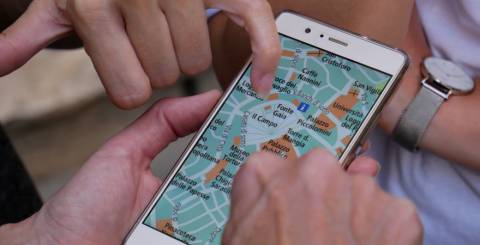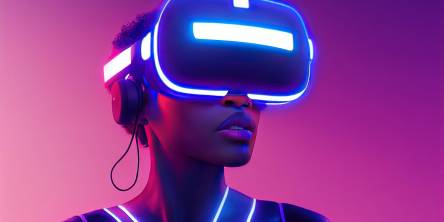Indoor Navigation App Development Benefits

An indoor navigation app or a system provides a user's geographical location and directions inside buildings. Indoor navigation can be used on multiple smart devices like mobiles, tablets, web, or directory devices. It can be used to search for any point of interest on a 3D digital map and can be navigated using turn-by-turn directions to reach the destination.
How does an indoor navigation system work? Most buildings have digital blueprints, and schematics & an effective indoor navigation app or system would rely on an accurate digital map to operate seamlessly. By implementing pathing (routes that users will need to navigate the space) and creating an indoor navigation system, start and end points can be user-defined to begin single or multi-floor navigation with turn-by-turn directions. Indoor navigation can be accessed using a mobile application, a website, or even digital directories placed in critical areas of a venue.
Difference between Indoor Positioning and Indoor Navigation
Indoor positioning and indoor navigation are two different technologies. Indoor positioning pinpoints a user's location, and indoor navigation suggests the best route to the end-point from where the user is located.
Indoor Navigation App Development Benefits
While many types of Indoor Navigation and tracking systems can be used, they all offer benefits. It could include;
- Accuracy - Indoor navigation systems and apps rely on different tracking technology and platforms to provide accurate location-based services. Indoor navigation systems offer similar results that GPS offers outdoors. They combine a building's digital blueprint with the required platform and technology to give accurate results.
- Saves time for users - Indoor navigation can help users from straying away from points of interest within a building. It can accurately guide them to their point of interest. This technology is particularly beneficial for malls as shoppers can pinpoint the shop without roaming. Similarly, the use of such apps for people attending conferences or exhibitions is immense. It helps point them to the correct location within the premises, helping eliminate time wastage.
- Real-time insights - It is possible to get intelligence about the activity in the facility. It can help the management locate personnel at any given time.
- Quicker incident response - Indoor navigation apps and systems can help keep people safe. In case of any emergency, such systems can guide people out of the premises by clearly indicating the safety points and exits. It can also help response providers locate the point of the issue and take steps to resolve the same.
- Notifications - By analyzing visitor history, the business can send trigger-based events and announcements to visitors or users when they are "spotted" at a particular point or pass by these platforms.
Different types of indoor tracking technology
Indoor navigation apps and systems use various wireless technologies to work. Indoor navigation relies more on radio frequency signals since these signals can pass through walls and other materials used within buildings.
- WiFi-based systems - These systems use the same infrastructure as wireless internet services by tracking an ID number or the MAC address of each connected device's WiFi card. They can have a range of approximately 150 meters which is long compared to other IPS systems. The disadvantage of such IPS systems is that they tend to be less accurate and can often be an object within 15 meters of its actual location.
- Bluetooth systems - Bluetooth IPS can be helpful if the building is populated with Bluetooth-enabled devices. Bluetooth IPS can help reduce costs by utilizing the existing Bluetooth network infrastructure. It offers a short range of approximately 25 meters but can be accurate to within 3 meters.
- Ultra-wideband (UWB) - UWB works on a higher frequency than Bluetooth or WiFi. It works exceptionally well in places with metal surfaces or thick walls, disrupting the lower frequencies of Bluetooth or WiFi. While the UWB systems come at a higher price point, they are very accurate and can place objects within a few centimeters with a range comparable to WiFi.
- Infrared (IR) - An infrared beam is used to transmit location data from tags to receivers like a TV remote. These systems use very little power and are low-cost to install and use. The downside is that these signals cannot pass through walls and their use can be limited depending on the application. It can give the best results if room-level accuracy is desired.
- Passive RFID - Passive Radio Frequency Identification (RFID) tags are power dependent and receive power wirelessly from receivers. They operate at a frequency that can pass through cloth and plastic material and does not require line-of-sight like the IR systems. Passive RFIDs have a concise range of approximately 15 centimeters. Such systems are well-suited for checkpoint scanners.
- Active RFID - Active RFID tags are not power dependent and have batteries & constantly broadcast their location to receivers. These have an extended range of approximately 50 to 150 meters in open environments. They offer the same reliable functionality as passive RFID tags at a higher price point.
- Acoustic (Ultrasound) - These systems use sound instead of light, like a "ping" of sonar signals. These systems are very accurate but cannot penetrate solid walls. These are suitable for use in large, open environments.
In conclusion, Indoor Navigation Apps and systems are advantageous to the business, providing users with reliable, economical, high-precision guidance. They are almost maintenance-free, offer offline capability & can be easily integrated into any software environment. They offer barrier-free advice to visually challenged people. The beneficiaries of these Indoor Navigation apps can be
- Universities
- Hospitals
- Hotels and resorts
- Office and property management companies
- Malls
- Stadiums and arenas
- Walking tour guides
- Museums
- Theme parks
- Libraries
Indoor Navigation apps are functional and extremely useful. Connecting with indoor navigation app development can give businesses actionable intelligence and create a powerful indoor navigation experience for users.
Similar Articles
Amazon Simple Queue Service (SQS), Simple Notification Service (SNS), and EventBridge are just a few of the messaging services that AWS provides to meet various demands when it comes to creating scalable and effective cloud systems.
Wearable technology, embracing devices small enough to be worn unobtrusively, constitutes a market that keeps expanding, and the momentum shows little sign of slowing
For job seekers, grasping the basic functions of Applicant Tracking Systems (ATS) is the first step in overcoming common job search barriers.
In the highly regulated world of pharmaceutical manufacturing, inventory management is far more than just tracking stock levels. It’s a critical component of ensuring product safety, quality, and compliance with current Good Manufacturing Practices (cGMP)
Find a reliable sealing technology with these 7 tips on quality, materials, certifications, and scalability to ensure lasting performance in your industry.
These days, your business depends on strong telecom systems and well-built software to stay ahead. Whether you’re launching a digital product or improving your communication tools, choosing the right team to work with makes a big difference.
Sometimes it seems like walking on a tight-rope when it comes to talking openly in team chats.
Learn how .NET Web API supports scalable architecture. Explore real-world best practices in .NET development for building high-performance, reliable endpoints.
Learn how to spot real fast USB-C charging by checking 4 key specs—output power, protocols, cable compatibility, and smart power distribution.









